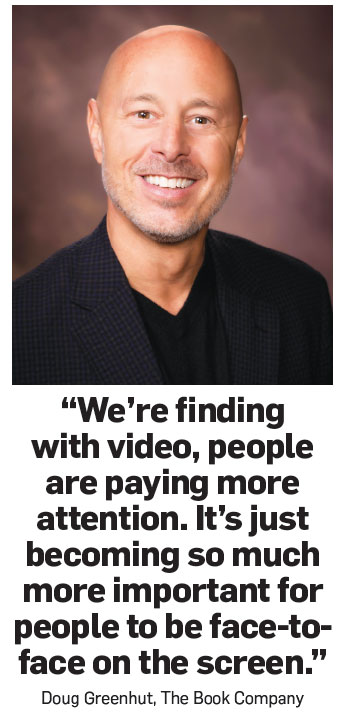Awards October 11, 2017
The Future of Customer Experience
Client needs are constantly changing. How can promo firms evolve to stay ahead?
For Doug Greenhut, president of supplier The Book Company (asi/41010), the ideal customer experience centers on partnership and consultation.
In a perfect world, “we wouldn’t be a product seller, we would be an idea provider,” he says. “Distributors would come to us where we could speak with them and consult with them on their sale so we could make sure their customers were getting a unique creative solution.”
He also notes in this dream scenario that everyone would plan ahead of time to eliminate needless rush orders, everything would ship UPS ground and arrive early and intact, and nothing would ever get lost.

Some of this might seem unattainable, but it should still be the goal. Distributors no doubt expect good communication, strong inventory, quick and accurate shipments, along with the best price possible. End-buyers have similar expectations, but may value price over communication or fast delivery over more imprint options.
So what can the promo products industry do to keep up, or better yet, get ahead of this evolving dynamic? Here, suppliers and distributors weigh in on what they see as the future of customer experience over the next few years – and offer ideas on how to approach what’s to come.
Supplier Side
First and foremost, communication is most important when evolving to meet customer needs. Businesses know customers are becoming less and less focused on in-person interaction – and some even hesitate to read an entire email. For suppliers, that can lead to a unique juxtaposition: distributors who want to know how a process works or the specs of a product, but who don’t want to visit to see it or read a lengthy description of details.
Greenhut has a forward-looking solution, though: video. The Book Company currently uses Google Hangouts for internal communications, and Greenhut sees how that can be beneficial to the customer of the future. He’s currently exploring two options: Soapbox, a Google Chrome add-in, which allows employees to create video responses for distributors, and Verishow, which enables video calls similar to Hangouts or Facetime.
“We’re finding with video, people are paying more attention,” he says. “It’s just becoming so much more important for people to be face-to-face on the screen. The more we can communicate face-to-face, the better the world’s going to be. We saw a big shift with email. Nobody wanted to talk to anybody anymore. They just wanted to email all the time. People are tired of reading emails. They don’t read all the details. And it’s very hard to build a relationship over email.”
Alex Morin, executive vice president of sales and marketing at Debco Solutions (asi/48885), agrees that video is a smart tool. He and his staff often send quick videos back to distributors asking over email or phone for more information about a product or process, noting “just because you were sent something in one medium doesn’t mean it has to go back in the same medium.” But he’s also aware that every distributor is different, and he knows his company must adhere to whatever type of communication the customer prefers.
“We have to be open to all of the different platforms and not just be focused on one of those,” Morin says. “It’s important that we’re able to answer texts, we’re able to do video chat, we’re able to engage on different social media platforms. We have to be able to understand and quickly adapt to the needs of different markets.”
Kathy Cheng, president at Redwood Classics Apparel (asi/81627), uses a similar tactic. She’ll reply to customers in whatever medium they’re more comfortable with – but she also believes that even though younger generations want to pick up a phone less, standard procedures need to be in place in order to save everyone time. For Redwood, that means if something takes more than two emails to resolve, it’s time to make a call. And even that can be accomplished digitally, if the customer desires.
“There’s definitely a need for face-to-face,” Cheng says. “I just think the platform in which those face-to-faces happen may be different and will evolve.”
So with changes in communication, and even in what counts as face-to-face conversation, will the ordering process become different too? Greenhut and Cheng don’t necessarily think so – at least not any time soon.
Both suppliers do see that distributors are looking up more and more products on mobile, especially if they’re in a client’s office at the time. Currently, though, intricacies make the order process a bit too difficult to do any other way than over the phone or on a computer.
“I think it would be nice if we could all start ordering on a mobile basis,” Cheng says. “It would be very challenging though, because we have so many different systems in our industry. How do you streamline that process? Can we do that? I don’t know if the order process can be as customized and direct as we’re hoping it could be.”
In short, we’ve got a long way to go before people can start ordering promo products with texts and emojis. Overall though, if that’s what customers want, promo firms ultimately need to figure out a way to make it happen.
“There’s too much of an idea out there that we have to do stuff to customers, we have to get customers to behave a certain way. And really, we need to behave a certain way so like attracts like,” says Lynn Hunsaker, president of ClearActionCX, a consulting firm whose specialty is improving customer experience. “The customer is in the driver’s seat and will be expecting that the experience in one part of their life will match the experience in other parts of their lives.”
Morin agrees, and notes that customers’ desire for the type of personalized and customized experience they get with one company will expand to every aspect of every company they interact with.
“That’s what we’re striving for here, truly understanding each customer that calls in and having the tools at our desk to be able to know their habits and demographics,” he says. “We’re professionals. We know our products, we know what’s new and how they resonate and what markets they work best in. If we can use that knowledge because we have the insights, then that phone call or email interaction can be so much more personalized. And that to me is the essence of where we’re going with customer service these days.”
Distributor Perspective
For distributors, everything in this discussion is a bit different. Their work with end-buyers and end-users demands a more text-based, hands-off approach, while still maintaining the personal touch clients need in order to feel valued as a customer.
“Customers shop online – that’s a fact,” says Jeff Becker, president of distributor Kotis Design (asi/244898). “The new generation only shops online. We’re evolving features to allow customers to do things themselves, because they don’t make phone calls anymore. They want the option to do what they want, when they want, however they want to do it. We’re building features that allow our customers to do things themselves while also being available any time they have questions.”

The same thing is happening over at Brand Fuel (asi/145025), where President Robert Fiveash communicates with customers over text-based media the most – think email, but also social media. Both Becker and Fiveash agree that the first priority is making sure customers are receiving communication in the way they want it. Both distributors ask their customers what they prefer and adhere to that request.
Hunsaker believes this is critical, and a chance to really learn what customers are looking for if distributors take advantage of it in the right way. “We’ve underutilized text analytics to-date,” she says. “If we were analyzing text from customers like with voice-to-text transcriptions or customer commentary databases, there’s a huge gold mine right there. Some companies are spending thousands of dollars on customer surveys and frankly, if they were making full use of what they already had on hand in customer commentary, it could be messaging the customers better and better aligning the organization with what the customers want.”
Video calls haven’t particularly taken hold yet on the distributor side; instead, firms are using other technologies that allow for interaction with clients in a more visual way, like sharing presentations and sending out collaborative surveys.
Like suppliers, Becker and Fiveash also don’t see mobile ordering – or really any way of ordering other than the traditional method – taking hold in the near term. They do see, though, that delivery could change to meet customer desires for fast order fulfillment.
“Self-automated trucks are going to decrease ship times,” Becker says, in a sci-fi look to the future of delivery. “Soon we’ll have suppliers who say they can deliver that day. We’ll put it on an airplane and put on sonic air and it will be delivered that day.”
But what won’t come with that order is any type of freebie – something not a single supplier or distributor we interviewed approved of as a way of keeping up with changing customer expectations.
“If it’s free, it’s not valued,” says Fiveash. “While we can’t always charge for creative and other things that do cost us money, we always show the client the cost on an invoice – even if we zero out that line item. Your clients who are reasonable and value you will let you charge for expenses, whereas those who won’t are only with you because you are inexpensive.”
Getting the Best Feedback
Suppliers and distributors agree: getting honest feedback from clients is key to maintaining a successful business and improving customer experience. But how exactly companies get and value feedback varies.

Robert Fiveash, Brand Fuel:
“Ask for feedback often and with regularity. We surveyed our client base a few years back and found out a client wasn’t happy with his Brand Fuel account executive (AE). Loved him as a person and friend, but mentioned that he struggled with the details – and to them it was all about details. We discussed it with the AE, made a change, and saved a six-figure account.”

Alex Morin, Debco Solutions:
“Learn to love complaints. They are possibly the most valuable bits of information you can collect, because out of a complaint always comes a solution. That is the key right there – not being pompous and arrogant, listening to peoples’ suggestions and especially their complaints.”

Kathy Cheng, Redwood Classics:
“Define who you believe your ultimate customer is. Focus on them. Hopefully you’ll already have relationships where you can develop very honest conversations. When your inhibitions are down and you’re willing to be more vulnerable, you’re opening up the door to more honest conversations.”

Jeff Becker, Kotis Design:
“If all you do is wait for customer feedback, you may or may not be getting feedback from the right customers. The online world is successful because of reviews. Allowing customers to make reviews easily is absolutely critical. You need to offer the correct incentive and a survey that’s not too difficult. If they don’t understand why they’re providing feedback, there’s no incentive for them. Ask the right questions. Make it easy.”
Email: jennifer@jenniferbillock.com
